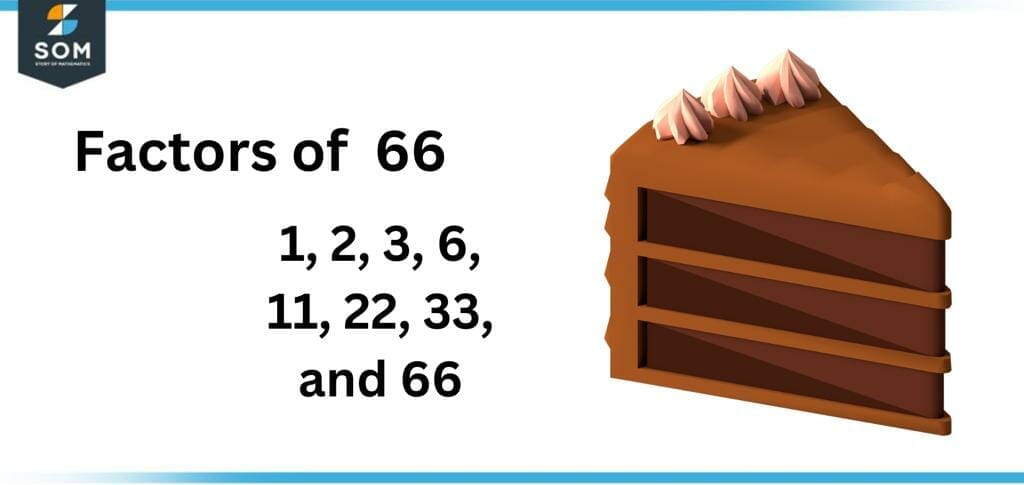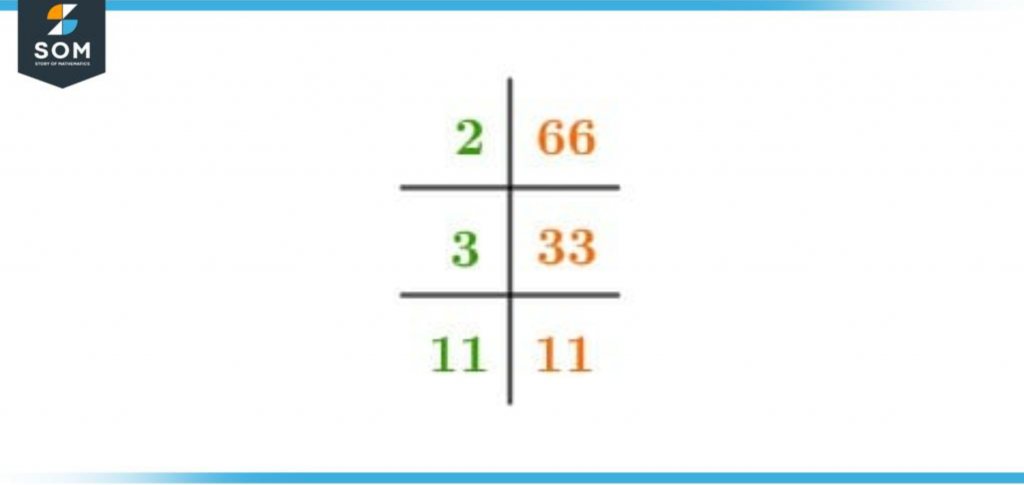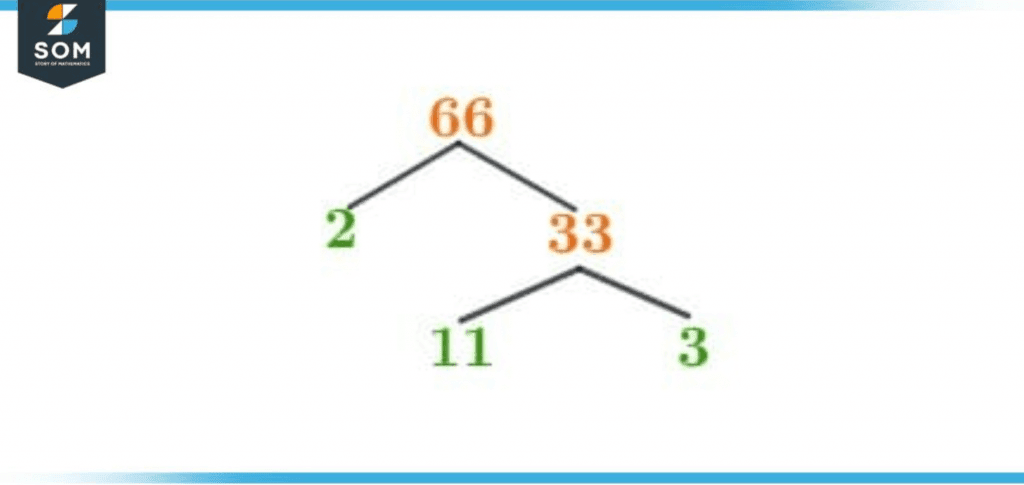JUMP TO TOPIC
Factors of 66: Prime Factorization, Methods, Tree, and Examples
The factors of 66 are supposed to be any number, positive or negative, which divides 66 fully (without leaving any remainder). This number is supposed to be an integer, meaning it can be any positive or negative whole number and cannot be in decimals or fractions.

Figure 1 – All possible Factors of 66
A factor of any given number cannot be larger than itself. This is an essential point to be kept in mind. If we divide any number with a number bigger than it, our answer will be in decimals, and any number in decimals cannot be a factor.
Before starting this topic, a few concepts regarding numbers must be clear in the findings for better understanding. Any even number will have 2 as its factor. Any number ending with 5 or 0 will have five as its factor. Any number, except for 0 and 1, will have two factors at least.
Any number having only two factors is a prime number, and other numbers with more than two factors are composite numbers. One and the number itself will be the only factors of any prime number. Now that you know these facts remember them while calculating factors.
Through this article, you can learn to calculate the factors of 66 through different methods. Methods of prime factorization and representation of factors through the factor tree will also be discussed later in this article. Once you go through this article, finding factors for any number will be your favorite task in mathematics.
What Are the Factors of 66?
The factors of 66 are 1, 2, 3, 6, 11, 22, 33, and 66 itself. These are all the numbers that can divide 66 by themselves without leaving any remainder.
They are all whole numbers. Since 66 has more than two factors, we can say that 66 is a composite number. By looking into the factors of 66, we can also see that it has 2 in its factors as it is an even number.
How To Calculate the Factors of 66?
You can calculate the factors of 66 by using two simple approaches for finding out the factors of 66: one is to find factors through division, and the second is by calculating through multiplication. We can say that both these methods are interrelated as well. Let’s start with the division method.
You can find two factors for a certain number by doing one successful division method. We will start by taking half of that number. A factor of any number cannot be larger than its half, except for itself. Keep this point in mind to save yourself some time and calculations.
Then we will start from the smaller numbers first. We will divide our given number with the number we chose. If it divides the given number fully, we will consider it and the quotient as the factors of that specific number. We will repeat the same process with another number if it cannot generate any such answer.
We will repeat the process until we have not done the calculations for every single number until half of that specific number. Be sure not to skip any number, as ignoring one can mean missing two factors. Also, don’t forget to add one and the number to the final list. If you do so, you might lose a score.
Now let’s practice this concept with the number 66. We will get the 66, dividing it with2. We will get the answer 33. Now we will take all the numbers between 1 and 33 to determine the factors of 66. Listed below are all the examples of the factors of 66 to help you understand better.
\[ \frac{66}{1} = 66 \]
\[ \frac{66}{2} = 33 \]
\[ \frac{66}{3} = 22 \]
\[ \frac{66}{6} = 11 \]
Now you can determine that the divisor and quotient are counted as factors for any number. You don’t necessarily have to repeat your workings for the quotients as you would get the same answers again.
Considering that the concept of multiplication is clear, we will now move to the second method, the method of multiplication. Our goal, in this method, is to achieve our given number as a product of two whole numbers.
You will start by taking two integers, both smaller than the given number, and then you will multiply them both to see if you get that number as their product or not. If yes, then you have calculated two factors of that specific number. If not, then you can try changing one number at a time until you are not able to retrieve the same answer.
Listed below is the example of factors of 66.
1 x 66 = 66
2 x 33 = 66
3 x 22 = 66
6 x 11 = 66
Here again, you can see that both the numbers used to get the product are considered as the factors of 66. Repeating the calculations for these numbers while going through your number list is not essential.
Factors of 66 by Prime Factorization
Prime factorization is a method to determine the prime factors of a number. Before moving deep into the topic, first, we have to know what the term ‘prime factors’ means. It refers to those factors of a number that are prime numbers. So if any number having two factors of itself is a factor of another, it would be called a prime factor.
For this method, we will again start with the smallest divisible number other than 1, first. Once we get the quotient, we will continue dividing both the quotient and divisor with their factors until we don’t get prime numbers. Remember that getting prime numbers as our final product is our goal for this method.
For 66, we will start dividing it by 2. We will get 33 as our quotient. Since 2 is a prime number, we will leave it and divide 33 by its smallest divisible number. Then we will get 3 and 11 as our answers. Our work will stop here as we have retrieved all the prime factors of 66.
Notice that other factors of 66 were not included in this work. This is because those factors were not prime factors and are not always included in this work. A picture of the prime factorization of 66 will be attached at the end of this article.
Thus by working through this method, we have discovered that 2, 3, and 11 are the only prime factors of 66.
The diagram of the Prime Factorization of 66 is attached below:

Figure 2 – Prime Factorization of 66
Factor Tree of 66
A factor tree is made to find the prime factors of a number. It can be considered the representation of prime factorization as the results of both methods are the same. Once you have completed drawing a factor tree, its structure will look like the structure of a family tree.
You might have to do quite a bit of work to make a factor tree for any composite number, but making a factor tree of any composite number is like a piece of cake as it only hastwo2 factors, both of which are prime numbers.
For making a factor tree of 66, 66 will be written on top. Then we will divide it by 2 (the smallest divisible number other than 1). We will get 33 as the answer. We will extend branches towards both sides and write both numbers on either side.
2 is a prime number, so it will be left as it was written, and we will divide 33 by its smallest divisible number, ‘3’. Our answer will now be 11. We will again write both these numbers by extending branches below 33.
As 3 and 11 are both prime numbers, our working will stop here, and the factor tree of 66 will now be completed. An image of a factor tree of 33 will be attached at this article’s end to understand this concept better.
Take a look at the Factor Tree of 66 in the diagram attached below:

Figure 3 – Factor Tree of 66
Factors of 66 in Pairs
Factor pairs are formed when two factors of a certain number multiply together to give you that certain number as a product. These factor pairs can be in positive or negative numbers.
When we find factors of a number through division, both the divisor and quotient form a factor pair for that number. When factors are calculated through multiplication, both integers are multiplied together to form a factor pair of that number.
Now let’s say you have a list of factors for any given number, and you must find the factor pairs. You will start multiplying every single number with other numbers to find which two numbers give you that number as a product.
Let’s figure out the factor pairs of 66 through multiplication and division.
66/1= 66 (66 and 1 form a factor pair)
66/2= 33 (33 and 2 form a factor pair)
3 x 22= 66 (3 and 22 form a factor pair)
6 x 11= 66 (6 and 11 form a factor pair)
The factor pairs of 66 are given as:
(1, 66)
(2, 33)
(3, 22)
(6, 11)
The negative factors are given as follows:
(-1, -66)
(-2, -33)
(-3, -22)
(-6, -11)
Factors of 66 Solved Examples
Example 1
List down the common factors between the factors 2 and 66.
Solution 1
The factors of 2 are given as:
Factors of 2 = 1, 2
Factors of 66 are given as:
Factors of 66= 1, 2, 3, 6, 11, 22, 33, 66
Common factors are:
Common Factors = 1 and 2
Example 2
Factorize 66 and list its prime factors.
Solution
The prime factorization of 66 is given as:
Prime Factorization = 2 x 33
Therefore, the prime factors of 66 are 2 and 33.
Images/mathematical drawings are made using GeoGebra.
